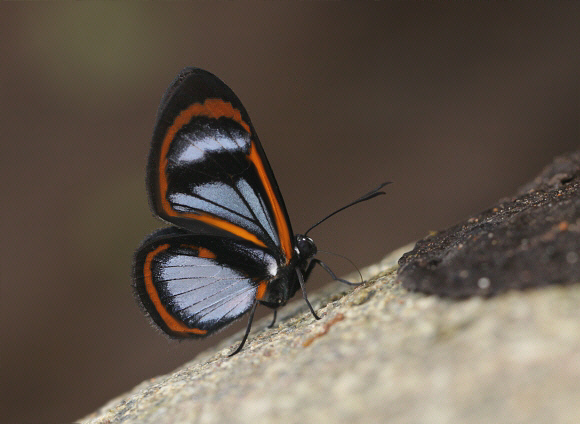 Ithomeis aurantiaca heliconina, Rio Onolulo, Tingo Maria, Peru -Adrian Hoskins
Ithomeis aurantiaca heliconina, Rio Onolulo, Tingo Maria, Peru -Adrian Hoskins
Introduction
There are 2 species in the genus Ithomeis, namely eulema from Central America, and aurantiaca from South America.There are many species which share the Ithomeis pattern of black, orange and large translucent areas. These include many toxic genera from the Ithomiinae ( Ithomia, Oleria etc ), and a number of toxic moths from the family Arctiidae. Additionally there are several other Riodinid genera that contain species with a similar colour theme – e.g. Stalachtis, Ithomiola and Brachyglenis.
Ithomeis aurantiaca produces several subspecies, many of which were formerly regarded as full species, but have since been relegated. These include satellites and astrea, both of which are very similar to the illustrated heliconina. Other subspecies include mimica and stalachtina, both of which have greatly reduced hyaline areas, and extensive orange markings – these subspecies bear a strong resemblance to toxic Ithomiines in the genera Pseudoscada, Hyposcada and Hypoleria. A single widely distributed species such as Ithomeis aurantiaca can produce several subspecies, each markedly different in appearance, and each mimicking a particular toxic Ithomiine species that occurs within the same area.
On his adventures in Amazonia the legendary explorer and naturalist Henry Walter Bates became fascinated by this genus, and by the amazing similarities between various other butterfly species. He realised that butterflies which are unpalateable to insectivorous birds are very often mimicked by similarly patterned palatable species. In 1862 he published the famous paper describing his theory, which is now commonly known as Batesian mimicry.
Ithomeis aurantiaca is distributed from Panama to Bolivia. The subspecies heliconina is confined to eastern Peru and the southern Amazonian ( Mato Grosso ) region of Brazil.
Habitats
This butterfly is found in cloudforest habitats at altitudes between about 800-1500m. It is a highly localised species and rarely seen.
Lifecycle
The eggs are pink, and laid in clusters of between 40-50 on the upperside of leaves. The larval foodplant is Heisteria ( Olacaceae ).
Adult behaviour
The adults are elusive, and usually encountered singly, in the vicinity of rivers or streams. At Rio Onolulo in Tingo Maria national park, Peru, I photographed the male shown on this page, and noted that it spent a considerable amount of time imbibing moisture from mossy rock faces and boulders. While feeding, the wings were slowly fanned; and when the insect took flight it fluttered its wings slowly, in a manner similar to that of Ithomiines. It seemed unperturbed by repeated disturbance by 4 keen photographers, and if molested always returned within a few seconds to resume feeding.

Ithomeis aurantiaca heliconina, Rio Onolulo, Tingo Maria, Peru – Adrian Hoskins
